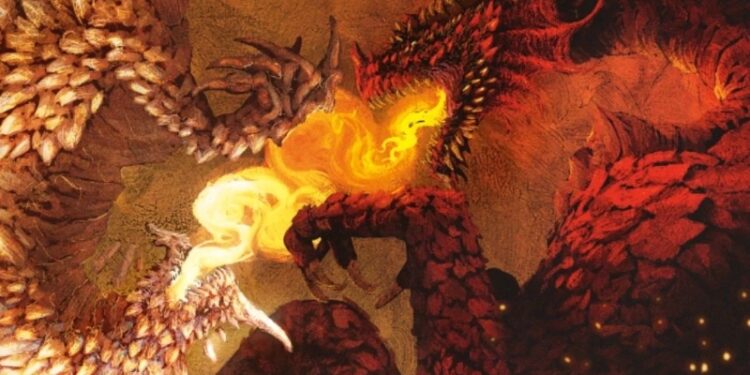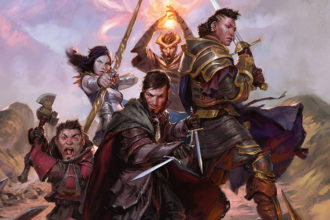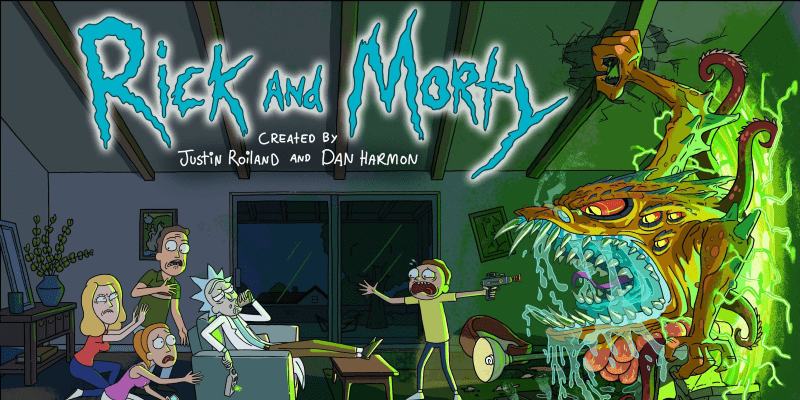
Dragons! Full of magic, am I right? In 5e D&D they sure are… other than the fact that most of them aren’t spellcasters (other than the psionic spellcasting of gem dragons), and their breath weapons and frightening presences aren’t magic. Aside from most of their stat blocks not needing the word “spell” or “magical” at any point, though, dragons are magic, which is why we’re starting this article with Chapter 2: Dragon Magic, a chapter of content that references dragons but isn’t for them unless the DM decides to take a few extra steps.
Part 1 | Part 2
Spells
New spells, seven in count. I’m probably not the only one who was instinctively expecting one per major dragon type or something.
Ashardalon’s stride is ultra-cinematic – it’s Zagreus’s fire feet Dash ability, in concept if not in exact effect. It’s more about the speed boost and opportunity attack avoidance than damage output (a very modest 1d6 for a 3rd-level spell) to creatures you come within 5 feet of, though both damage and speed scale with higher spell levels. There’s no attack roll or save for the damage, though, because it’s a buff on the caster, so that’s an interesting wrinkle.
On a personal note, I’m playing a wizard in a game where the encounter designs often reward mobility, so this is a very appealing spell for me once 3rd-level spells are on the table.
Draconic Transformation is the highest-level spell of the collection, at 7th, and it’s fairly self-explanatory why dragons don’t use this one, wouldn’t you say? (Very important sidebar: would you stat Maleficent as a shapeshifted dragon with a modest caster stat block, or an archmage with this spell, or arguably shapechange?) The spell gives you Flying, and for 1R you get +1/+0 until end of turn.
No sorry, I mean to say: blindsight, a 6d8 force damage breath weapon, 60-ft cone, that you can use as a bonus action every round of the duration(!), and wings that give a 60-ft flying speed. It’s still a lot more reasonable than shapechange into a dragon with your 9th-level spell slot, I guess.
Inasmuch as I have a criticism of this spell, it is to wish that upcasting it got you extra features. Cast with an 8th-level slot for damage resistance of some kind, or a huge pile of temp hp, AC, and claws. Frightening Presence too, maybe. I’m just really interested in weirder, more varied At Higher Levels options at this point.
Fizban’s Platinum Shield at 6th level is a hat-trick of defensive buffs for a single target: half cover; resistance to acid, cold, fire, lightning, and poison damage; and evasion. If you’re up against a Dex-targeting breath weapon, accept no substitutes. You can even move it to a new target on later turns, as a bonus action.
I like the “platinum-plated dragon scale” material component. I think you could hang an amazing story off of questing for a platinum scale from Bahamut himself, and having that superior component improve the spell somehow.
Nathair’s Mischief is a 2nd-level spell that creates a 20-foot cube of random effects, from a d4 table. The cube’s effect is new each round, and includes charmed (Wis save to resist), blinded (Dex save to resist), incapacitated (Wis save to resist), or difficult terrain. I said this when the spell showed up in UA and I’ll say it here – incapacitated is a lot. Incapacitated is the fundamental action-denial condition, so it’s interesting to see the metagame shift away from counterspell denial while introducing “every monster type suffers equally, but legendaries most of all” denial. I’m overstating somewhat – metallic dragonborn, a 2nd-level spell, and a 4th-level spell are not a trend-line – but it isn’t something we’ve seen often before this. Hypnotic pattern and precious little else.
Raulothim’s Psychic Lance is the 4th-level spell in question. It’s a single-target damage + incapacitated effect, on a failed Int save; on a success, half damage and no incapacitation. One of the cool things here is that you don’t have to be able to see the target if you know the target’s name. (There’s no handling for creatures with lots of different names, or two creatures that share a name because one is a faker or whatever.)
One of the interesting meta-considerations about this kind of spell is that, as a single-target incapacitation, it’s a boss-killer. It’s here to eat legendary resistances while still giving you some throughput. There’s been a ton of discourse about legendary resistances as a thing specifically because of the high-end stat blocks in this book. What I want to stress is that there’s more going on in the meta than screwing over spellcasters by proliferating LRs – there are also spells that move you closer to both hit points = 0 and landing a serious lockdown effect, and you probably want at least one good go-to there at level 11+. (This isn’t the place to rehash Stunning Strike issues, please and thank you.)
Rime’s Binding Ice at 2nd level is a lot like a lower-level cone of cold that delivers on the concept as much or more than the raw damage – specifically, it snares targets in place for 1 minute (speed 0) on a failed Con save. It costs an action to break yourself or another snared creature out of the ice. I’m very into the damage/control blend here.
If you were to use the Spell Damage guidelines of the DMG, which I hasten to point out that WotC does not, this deals the expected damage for a 2nd-level AoE, and the snare is “free.” It’s also an instantaneous effect with a potential for action cost, which seems huge in this concentration-heavy spell collection.
Summon Draconic Spirit at 5th level follows the lead of summon spells from Tasha’s Cauldron of Everything, with a custom and scaling stat block. At the time of casting, you choose for it to be chromatic, gem, or metallic, which influences its appearance, damage resistances, and breath weapon damage type. The draconic spirit is Large and I guess it’s corporeal enough to ride as a mount, if you’re okay with losing your mount on a failed concentration save? Its breath weapon isn’t a ton of damage, but it’s usable every round as part of Multiattack.
This looks like fun if you’re up for managing a summoned creature. Good or great AC, but the hit points might feel a little lackluster – just keep in mind that (AoEs notwithstanding) it’s damage that you don’t have to heal afterward.
Last note on spells: draconic transformation, Fizban’s platinum shield, and summon draconic spirit all have 500-gold-piece material components that aren’t consumed on casting. It’s something to spend money on, even if you get to keep using it, I guess? Each of these items would be a super fun thing to get to steal or loot from an NPC spellcaster! (In a second we’re going to see why they’re all exactly 500 gp.)
Magic Items
Usually in breakdown articles I have very little to say on magic items. This book is very much the exception to that rule, though I still don’t expect to comment on all 17 items.
The first thing you notice (if you’re me, whatever) is that there are magic items linking to each of the gem dragons specifically, though not all of them are made from gem dragon parts the way the crystal blade, sapphire buckler, and topaz annihilator are. Only the crystal blade is described as a part that the dragon probably wouldn’t lose willingly – the other two are just scales.
I’m pleased and amused by the dragonhide belt, because its ki-replenishing function is not dissimilar to some monk belts I wrote a year and a half ago. What I’m saying is that I feel validated in my choices. It also boosts the DCs of your monk effects that require saves… like Stunning Strike. It’s also a rare bit of help for the Four Elements Total Landscaping monk – they’re still really bad, but this magic item gives them more ki to play with and improves their DCs!
If you’re looking for best-in-slot belt options, though—if “best in slot” is even a fragment of how you process magic items—it might still lose out to the belt of dwarvenkind (+2 Con! Poison resistance! Beards!) or the belt of giant strength (the steady damage output of 21-29 Strength can’t be overstated).
Dragonlances. This item is a full-on mic drop as far as I’m concerned. They’re the first of several beefy legendary items in this collection, but more than that, they’re dragonlances. +3 weapons, and +3d6 force damage to Dragon targets, and a dragon ally of yours gets to make a melee attack as a reaction. It’s no “you deal extra damage equal to your maximum hit points,” but that was always completely bananas.
The flail of Tiamat might be one of the highest damage-output items I’ve ever seen in 5e? Nepenthe from Van Richten’s Guide to Ravenloft is the only competitor I’m finding on a very casual search. Anyway, +5d4 damage per hit, of a damage flavor of your choice, is big, plus it gives you a 14d6 breath weapon 1/day. I’m honestly surprised it’s not sentient to at least add some complication and drawback to it.
The new figurine of wondrous power, a gold canary, is another legendary item. It becomes (imagine me, dropping a monocle) an adult gold dragon. No legendary or lair actions, and you can only summon it once per year. Once per campaign, for most campaigns; maybe less, if you’re like me and spend your consumables with extreme reluctance. There’s also a giant canary that you can summon once per day. It’s still amazing, just… actually use its dragon form, don’t be like me.
D&D now has its third legendary potion, in the potion of draconic majesty. You become an adult dragon for an hour, without legendary actions, lair actions, or the Change Shape trait. More ultra-powerful consumables? This is a personal attack.
The ruby weave gem lets you ignore a material component of up to 500 gp per charge expended, and the ruby regains three charges a day; it also adds one spell from any spell list to your spells known. What I love about this is the edges of a story about magic and spell knowledge that it implies in relation to Sardior. Gotta wonder if the designers are thumbing their noses at heroes’ feast specifically or only incidentally.
The topaz annihilator is a magical firearm that shoots necrotic damage… and once per day, a disintegrate spell. Pretty sure the last time I saw one of these bad boys was in Din Djarin’s hands.
Oh, jeez, reinterpreting the Mandalorians as a dragon cult in your setting could be amazing.
Hoard Magic Items
This is a new family of items joined by a system for gaining and losing power. The idea is that they’re uniquely bound to the presence and power of dragons, and gain power from resting in the mathom-houses of the wyrms of old. Could be in the now-lost home of a dwarf-clan, who can say? Point is, each item has an Uncommon, Rare, Very Rare, and Legendary power level, and you can elevate the item’s power by leaving it in the hoard of a dragon of the appropriate power level for a year, or by killing a dragon of the appropriate power level and waiting around for the next eight hours. Whichever.
The core point is that between these items and the Vestiges of Divergence in Explorer’s Guide to Wildemount, that’s two great models for magic items that you can level up repeatedly during a campaign. It’s getting at the thing I love about Earthdawn and 3.5e’s Weapons of Legacy without crappy decision moment of whether each experience point goes to you or your stuff. (To be honest, I don’t remember if WoL works that way.)
The two minor downsides of these items are that WotC isn’t going to want to reiterate this rules structure in future books, so we’ll probably never get another hoard item; and for these to advance, you probably want at least one major dragon encounter per tier. There’s nothing wrong with that, but it’s a lot more than any campaign I’ve ever been in. On the plus side, the rest of this book is laser-focused on getting more dragons into the action of everyone’s games.
The four example hoard items are a weapon, a spellcasting focus, a drinking vessel, and an adornment (what 4e would call a neck-slot item). Most of all I appreciate that dragons learned the secret of uisce beatha, presumably long before other peoples. With their body mass, it’s presumably necessary to distill. The items are all very cool and just ridiculously badass once they get to very rare or legendary. Also, it’s fun to see 5e’s concept of what an energy burst weapon might mean – a 5-ft AoE centered on the target, affecting only creatures of your choice, on a crit.
Draconic Gifts
I’ve mentioned before my love of supernatural gift rules and the design team gradually broadening their implementation over the years. This is another example of that, with eight new gifts, graduated by draconic age category. There’s also a key sidebar suggesting the use of bonus feats as draconic gift stand-ins.
I don’t have a ton more to say about these except that I love the race-change mechanics of the Draconic Rebirth gift. I like the possibility of major character changes that you could opt into, if it felt interesting at the time. Any DM could just make it happen, but this suggests structure and leaves you with more than a 1:1 swap.
Conclusion
That gets us to the end of Chapter 2. It’s a juicy chapter of payoffs for a lot of the stuff that Chapters 3-6 are going to put you through, as a player. Some things here aren’t going to fit the tone and style of every campaign – the topaz annihilator, for one. You might get some puzzled looks from me if you have dragonlances in your Eberron campaign.
Tune in next time for Chapters 3 and beyond. I think we’ll be getting through more than one chapter at a time from here on out in this series!



